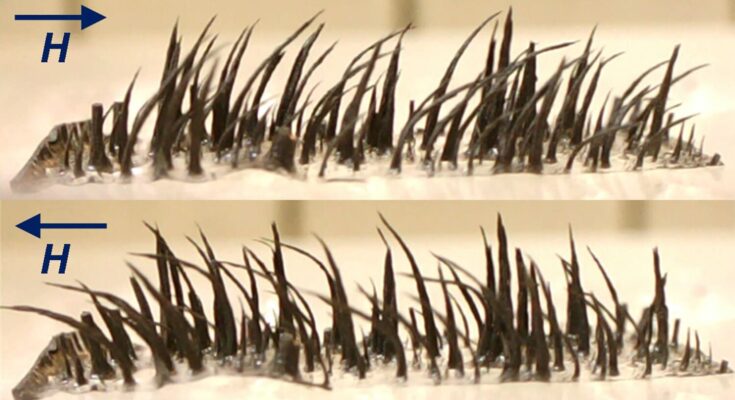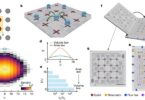Bending of NdFeB based magnetic cilia with magnets pointing in horizontal magnetic fields. Credit: Matthew R. Clary.
Magnetic cilia—artificial hairs whose movement is driven by embedded magnetic particles—have been around for a while, and are of interest in applications such as soft robotics, moving objects and mixing water. However, the existing magnetic cilia move in a fixed direction.
Now researchers have shown how to make magnetic cilia that can be “reprogrammed,” changing their magnetic field at room temperature to change the movement of the cilia when needed.
Most magnetic cilia use “soft” magnets, which do not produce a magnetic field but become magnetized in the presence of a magnetic field. Only the last few magnetic cilia have used ‘hard’ magnets, which can generate their own magnetic force.
One of the advantages of using hard magnets is that they can be configured, which means that you can give the magnetic field produced by the material a certain polarization. Controlling the magnetic polarization – or magnetization – allows you to precisely control how the cilia will change when an external magnetic field is applied.
“What’s new about this work is that we’ve demonstrated a method that allows us to not only organize the cilia, but also in a controlled manner,” says Joe Tracy, co-author of the paper on the work. and professor of materials science and engineering. at North Carolina State University.
“We can change the direction of the material’s magnetization at room temperature, which allows us to completely change how the cilia change. It’s like getting a swimmer to change their stroke.”
For this task, the researchers created magnetic cilia with a polymer embedded with magnetic microparticles. In particular, the microparticles are neodymium magnets – powerful magnets made of neodymium, iron and boron. The paper, “Magnetic Reprogramming of Self-Assembled Hard-Magnetic Cilia,” is published in the journal. Advanced equipment technology.
To create the cilia, researchers introduce magnetic microparticles into a polymer dissolved in a liquid. This slurry is exposed to an electric field of sufficient strength to give all the microparticles the same magnetic force.
At that time using a weak magnetic force when the water polymer dries, the researchers are able to control the behavior of the microparticles, which causes the formation of cilia that are constantly separated across the substrate.
“This carpet of regularly ordered cilia is programmed to behave the same way when exposed to an external magnetic field,” says Tracy. “But what’s really interesting here is that we can reprogram the behavior.” boo, so that the cilia can be restored to a completely different function.”
To do so, the researchers first put the cilia in ice, which fixes all the cilia in the desired way. The researchers then expose the cilia to a wavy, variable magnetic field that has the effect of disrupting the magnetic field of the microparticles. In other words, they largely cancel the organized magnetization that was shared by all the microparticles when the cilia were made.
“The reprogramming step is straightforward,” says Tracy. “We use an oscillating field to restore the magnetization, and then apply a strong magnetic field to the cilia that allows us to magnetize the microparticles in a new way.”
“By canceling the initial magnetic field, we are able to reprogram the magnetization of the microparticles,” says Matt Clary, first author of the paper and a Ph.D. student at NC State. “We show in this work that if you omit that annealing step you have less control over the magnetization pattern of the microparticles when you rearrange them.”
“We also found that when the magnetization of the microparticles is perpendicular to the long axis of the cilia, we can make the cilia ‘lift’ in the rotating field, which means that they suddenly change their orientation,” says Tracy.
In addition, the research group developed a computational method that allows users to predict the bending behavior of magnetic cilia based on hard magnets, depending on the polarization of the cilia.
“This model can be used in the future to guide the design of hard magnetic cilia and associated soft actuators,” says Ben Evans, co-author of the paper and professor of physics at Elon University.
“Ultimately, we think this work is important in the field because it allows the regeneration of magnetic cilia for new functions or applications, especially in remote areas,” Tracy says. “The methods developed in this work can also be used in the wider field of soft magnetic actuators.”
This paper was written by Saarah Cantu, a former graduate student at NC State; and Jessica Liu, former Ph.D. student at NC State.
Additional information:
Matthew R. Clary et al, Magnetic Reprogramming of Self-Assembled Hard-Magnetic Cilia, Advanced equipment technology (2024). DOI: 10.1002/admt.202302243
Newspaper articles:
Advanced equipment technology
#Researchers #show #teach #ways #magnetic #cilia






